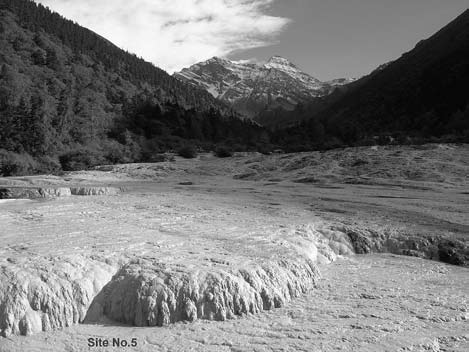Spatial and temporal hydrochemical variations of the spring-fed travertine-depositing stream in the Huanglong Ravine, Sichuan, SW China
DOI:
https://doi.org/10.3986/ac.v39i2.97Abstract
Automatic hydrochemical logging and in situ titration combined withlaboratory analysis were used to understand the spatial and temporal hydrochemical variations of the spring-fed, travertine-depositing stream in celebrated Huanglong Ravine, Sichuan, SW China. This is essential for protection of the Huanglong World Natural Heritage travertine landscape. It was found that the deposition of travertine was due to very strong CO2 degassing from the water, leading to decrease in pCO2 and specific conductivity (SpC), and increase in pH and SIc downstream from the Spring. However, regular downstream hydrochemical evolution was interrupted by dilution withsnow-melt water and by renewed CO2 from some downstream springs. The chemistry of Huanglong Spring itself was stable at a diurnal scale thoughit was altered by the great Wenchuan earthquake of May 12 2008. However, in spring-fed pools downstream, pCO2 and SpC were lower, and pH and SIc were higher in daytime than at night, whichindicates that the deposition of travertine was faster during the daylight hours. This was due to the combined effects of higher water temperatures and higher aquatic algae photosynthesis. In addition, it was found that the phosphate concentration in the stream increased remarkably downstream in the tourist midseason, indicating water pollution by tourism activities. The increase of phosphate (an inhibitor of calcite precipitation) may be one of the reasons for the decrease in travertine deposition rates and accelerated propagation of discoloration by diatoms during the past decades, whichneeds to be given more comprehensive study and tackled in future for the protection of these world famous travertine deposits.Downloads
Download data is not yet available.

Downloads
Published
2010-06-01
How to Cite
Wang, H., Liu, Z., Zhang, J., Sun, H., An, D., Fu, R., & Wang, X. (2010). Spatial and temporal hydrochemical variations of the spring-fed travertine-depositing stream in the Huanglong Ravine, Sichuan, SW China. Acta Carsologica, 39(2). https://doi.org/10.3986/ac.v39i2.97
Issue
Section
Original papers
License
Authors guarantee that the work is their own original creation and does not infringe any statutory or common-law copyright or any proprietary right of any third party. In case of claims by third parties, authors commit their self to defend the interests of the publisher, and shall cover any potential costs.
More in: Submission chapter




